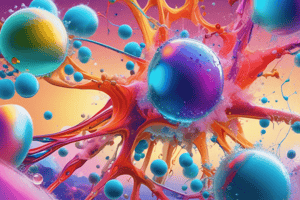Podcast
Questions and Answers
What is the noble gas configuration for Nickel?
What is the noble gas configuration for Nickel?
- [Ar] 4s2 3d8 (correct)
- [Xe] 6s2
- [Ne] 3s2 3p6 4s2 3d8
- [Kr] 5s2 4d8
Mendeleev arranged the periodic table based on increasing atomic mass.
Mendeleev arranged the periodic table based on increasing atomic mass.
True (A)
Write the full electron configuration for Chromium.
Write the full electron configuration for Chromium.
1s2 2s2 2p6 3s2 3p6 4s2 3d4
The rows on the periodic table are called ______.
The rows on the periodic table are called ______.
Match the following groups of elements with their properties:
Match the following groups of elements with their properties:
What happens to the atomic radius as we move across a period from left to right?
What happens to the atomic radius as we move across a period from left to right?
Identify the element with the electron configuration 1s22s22p63s23p64s2.
Identify the element with the electron configuration 1s22s22p63s23p64s2.
Ionization energy increases as you go down a group in the periodic table.
Ionization energy increases as you go down a group in the periodic table.
Which of the following elements has an atomic number of 56?
Which of the following elements has an atomic number of 56?
The number in the isotopic notation of an element indicates the number of protons only.
The number in the isotopic notation of an element indicates the number of protons only.
How many valence electrons does Calcium have?
How many valence electrons does Calcium have?
The element with an atomic number of 8 and 10 neutrons is represented as ______.
The element with an atomic number of 8 and 10 neutrons is represented as ______.
Match the following ionic properties with their respective elements:
Match the following ionic properties with their respective elements:
What is the correct average atomic mass formula for calculating isotopes?
What is the correct average atomic mass formula for calculating isotopes?
An electron configuration must always fill the lowest energy orbitals first before moving to higher ones.
An electron configuration must always fill the lowest energy orbitals first before moving to higher ones.
What is the resulting ion notation for Chlorine after it gains an electron?
What is the resulting ion notation for Chlorine after it gains an electron?
What is the correct formula to calculate the energy of a photon?
What is the correct formula to calculate the energy of a photon?
The unit of Planck's constant is Joule-second.
The unit of Planck's constant is Joule-second.
What is the correct Lewis Dot Structure for oxygen?
What is the correct Lewis Dot Structure for oxygen?
The chemical formula for sodium phosphide is ______.
The chemical formula for sodium phosphide is ______.
Match the following elements with their correct chemical formulas for binary ionic compounds:
Match the following elements with their correct chemical formulas for binary ionic compounds:
Which of the following describes the correct naming convention for the compound Cr2O3?
Which of the following describes the correct naming convention for the compound Cr2O3?
A ternary ionic compound contains only two elements.
A ternary ionic compound contains only two elements.
What is the formula for Nickel (III) phosphate?
What is the formula for Nickel (III) phosphate?
The speed of light is represented by the letter ______.
The speed of light is represented by the letter ______.
Flashcards
Electron Orbital Diagram for Carbon
Electron Orbital Diagram for Carbon
A visual representation of electron arrangement in carbon's atomic orbitals showing the filling pattern in its ground state.
Electron Configuration for Aluminum
Electron Configuration for Aluminum
The arrangement of electrons in Aluminum's atomic orbitals in the ground state, represented in a sequence of energy levels.
Electron Configuration for Chromium
Electron Configuration for Chromium
The arrangement of electrons in Chromium's atomic orbitals in the ground state, which deviates from the standard predicted configuration due to electron stability.
Identifying Element from Electron Configuration [1s22s22p63s23p64s2]
Identifying Element from Electron Configuration [1s22s22p63s23p64s2]
Signup and view all the flashcards
Noble Gas Configuration for Tin
Noble Gas Configuration for Tin
Signup and view all the flashcards
Noble Gas Configuration for Nickel
Noble Gas Configuration for Nickel
Signup and view all the flashcards
Periodic Table Rows
Periodic Table Rows
Signup and view all the flashcards
Periodic Table Columns
Periodic Table Columns
Signup and view all the flashcards
Atomic notation for Iron
Atomic notation for Iron
Signup and view all the flashcards
Atomic notation for Barium
Atomic notation for Barium
Signup and view all the flashcards
Atomic notation for Xenon
Atomic notation for Xenon
Signup and view all the flashcards
Average atomic mass calculation formula
Average atomic mass calculation formula
Signup and view all the flashcards
Isotopic notation
Isotopic notation
Signup and view all the flashcards
Valence electrons and Sulfur
Valence electrons and Sulfur
Signup and view all the flashcards
Valence electrons and Chlorine
Valence electrons and Chlorine
Signup and view all the flashcards
Valence electrons and Calcium
Valence electrons and Calcium
Signup and view all the flashcards
Photon Energy Formula
Photon Energy Formula
Signup and view all the flashcards
Planck's Constant Units
Planck's Constant Units
Signup and view all the flashcards
Photon Frequency Units
Photon Frequency Units
Signup and view all the flashcards
Calculate Photon Frequency
Calculate Photon Frequency
Signup and view all the flashcards
Binary Ionic Compound Formula
Binary Ionic Compound Formula
Signup and view all the flashcards
Lewis Dot Structure for Phosphorus
Lewis Dot Structure for Phosphorus
Signup and view all the flashcards
Magnesium Lewis Dot Structure
Magnesium Lewis Dot Structure
Signup and view all the flashcards
Ternary Ionic Compound Formula
Ternary Ionic Compound Formula
Signup and view all the flashcards
Study Notes
States of Matter and Their Properties
- Solids have a definite shape and volume.
- Liquids have no definite shape but have a definite volume.
- Gases have no definite shape or volume.
- Solids have almost no movement of atoms, are incompressible and have low thermal expansion
- Liquids have moderate atom movement, are almost incompressible and have moderate thermal expansion
- Gases have free movement of atoms, are compressible and have high thermal expansion
Phase Changes
-
Melting: Solid to liquid
-
Freezing: Liquid to solid
-
Evaporation: Liquid to gas
-
Condensation: Gas to liquid
-
Sublimation: Solid to gas
-
Deposition: Gas to solid
-
Diagrams illustrating particle structures for each phase change should be studied.
Types of Matter
- Matter:
- Can be physically separated? (yes/no)
- Is the composition uniform? (yes/no)
- Can it be chemically decomposed? (yes/no)
- This flowchart defines elements, compounds and mixtures.
Physical and Chemical Properties
- Physical Property: A characteristic that can be observed or measured without changing the substance's chemical composition.
- Examples: color, odor, density, melting point, boiling point, hardness, solubility, conductivity, malleability (easily hammered into thin sheets), ductility (drawn into wire).
- Chemical Property: A characteristic that describes how a substance reacts with other substances to form new substances.
- Examples: flammability (ability to burn), reactivity with acids or bases, ability to rust, oxidization.
Physical and Chemical Changes
- Physical Change: A change in a substance's physical properties, but not its chemical composition.
- Examples: melting, freezing, boiling, dissolving, crushing, cutting.
- Chemical Change: A change in a substance's chemical composition, resulting in new substances being formed.
- Examples: burning, rusting, cooking, oxidation, corrosion, reaction with another substance
Density
- Density is defined as mass per unit volume.
- This is measured in g/mL or g/cm3
- The mathematical formula relating mass (m), volume (v) and density (d) is: d = m / v
- Density is an intensive property
Atomic Structure
- Diagrams of atomic models and discoveries made by various scientists are to be studied.
Atomic Notation
- Atomic number and mass number are represented in atomic notation, eg. 12C(6).
- The number below the element symbol refers to the atomic number
- The number above the element symbol refers to the mass number
Average Atomic Mass
- The average atomic mass is calculated by taking the sum of the masses of the isotopes, multiplied by their relative abundances. .
- The formula is (mass * %abundance) + (mass * %abundance)... etc
Periodic Table Trends
- The periodic table is arranged by increasing atomic number.
- Elements in the same column (group) have similar chemical properties.
- Elements in the same row (period) have varying properties, but show trends in properties as the period progresses.
- Trends include atomic radius, electronegativity, ionization energy
Chemical Reactions
- Five basic types of chemical reactions, along with their general equation and characteristics, are to be studied.
Balancing Chemical Equations
- Understand how to balance chemical equations to ensure mass is conserved.
- Know how to state the types of reactions (synthesis, decomposition, single and double displacement).
Studying That Suits You
Use AI to generate personalized quizzes and flashcards to suit your learning preferences.




